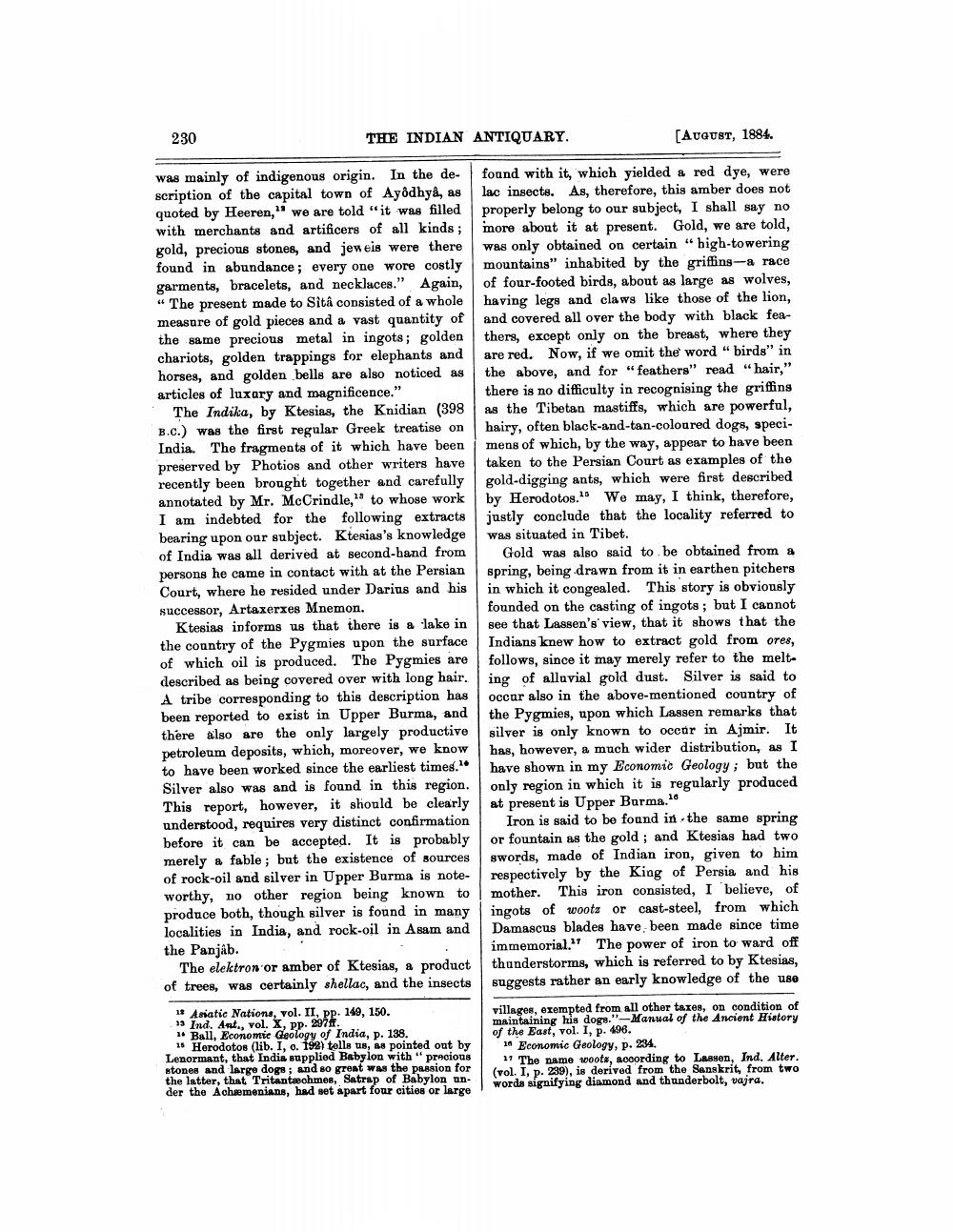________________
230
THE INDIAN ANTIQUARY.
was mainly of indigenous origin. In the description of the capital town of Ayodhya, as quoted by Heeren," we are told "it was filled with merchants and artificers of all kinds; gold, precious stones, and jeweis were there found in abundance; every one wore costly garments, bracelets, and necklaces." Again, "The present made to Sitâ consisted of a whole measure of gold pieces and a vast quantity of the same precious metal in ingots; golden chariots, golden trappings for elephants and horses, and golden bells are also noticed as articles of luxary and magnificence."
18
The Indika, by Ktesias, the Knidian (398 B.C.) was the first regular Greek treatise on India. The fragments of it which have been preserved by Photios and other writers have recently been brought together and carefully annotated by Mr. McCrindle, to whose work I am indebted for the following extracts bearing upon our subject. Ktesias's knowledge of India was all derived at second-hand from persons he came in contact with at the Persian Court, where he resided under Darius and his successor, Artaxerxes Mnemon.
Ktesias informs us that there is a lake in the country of the Pygmies upon the surface of which oil is produced. The Pygmies are described as being covered over with long hair. A tribe corresponding to this description has been reported to exist in Upper Burma, and there also are the only largely productive petroleum deposits, which, moreover, we know to have been worked since the earliest times.1 Silver also was and is found in this region. This report, however, it should be clearly understood, requires very distinct confirmation before it can be accepted. It is probably merely a fable; but the existence of sources of rock-oil and silver in Upper Burma is noteworthy, no other region being known to produce both, though silver is found in many localities in India, and rock-oil in Asam and the Panjab.
The elektron or amber of Ktesias, a product of trees, was certainly shellac, and the insects
12 Asiatic Nations, vol. II, pp. 149, 150.
13 Ind. Ant., vol. X, pp. 297ff.
1 Ball, Economic Geology of India, p. 138.
15 Herodotos (lib. I, o. 192) tells us, as pointed out by Lenormant, that India supplied Babylon with "precious stones and large dogs; and so great was the passion for the latter, that Tritantechmes, Satrap of Babylon under the Achaemenians, had set apart four cities or large
[AUGUST, 1884.
found with it, which yielded a red dye, were lac insects. As, therefore, this amber does not properly belong to our subject, I shall say no more about it at present. Gold, we are told, was only obtained on certain "high-towering mountains" inhabited by the griffins-a race of four-footed birds, about as large as wolves, having legs and claws like those of the lion, and covered all over the body with black feathers, except only on the breast, where they are red. Now, if we omit the word "birds" in the above, and for "feathers" read "hair," there is no difficulty in recognising the griffins as the Tibetan mastiffs, which are powerful, hairy, often black-and-tan-coloured dogs, specimens of which, by the way, appear to have been taken to the Persian Court as examples of the gold-digging ants, which were first described by Herodotos. We may, I think, therefore, justly conclude that the locality referred to was situated in Tibet.
Gold was also said to be obtained from a spring, being drawn from it in earthen pitchers in which it congealed. This story is obviously founded on the casting of ingots; but I cannot see that Lassen's' view, that it shows that the Indians knew how to extract gold from ores, follows, since it may merely refer to the melting of alluvial gold dust. Silver is said to occur also in the above-mentioned country of the Pygmies, upon which Lassen remarks that silver is only known to occur in Ajmir. It has, however, a much wider distribution, as I have shown in my Economic Geology; but the only region in which it is regularly produced at present is Upper Burma.10
Iron is said to be found in the same spring or fountain as the gold; and Ktesias had two swords, made of Indian iron, given to him respectively by the King of Persia and his mother. This iron consisted, I believe, of ingots of wootz or cast-steel, from which Damascus blades have been made since time immemorial." The power of iron to ward off thunderstorms, which is referred to by Ktesias, suggests rather an early knowledge of the use
villages, exempted from all other taxes, on condition of maintaining his dogs."-Manual of the Ancient History of the East, vol. I, p. 496.
18 Economic Geology, p. 234.
17 The name woots, according to Lassen, Ind. Alter. (vol. I, p. 239), is derived from the Sanskrit, from two words signifying diamond and thunderbolt, vajra.




